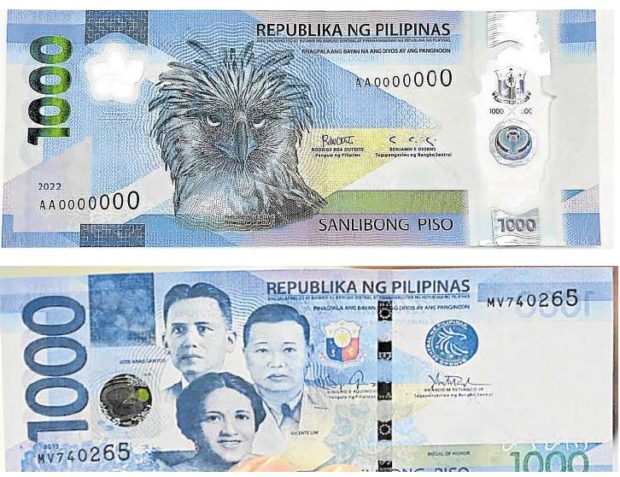
NEW DESIGN New P1,000 bills featuring the Philippine eagle (top) will be issued in April next year. The current note features three heroes who sacrificed their lives during the Japanese occupation. —PHOTO FROM BANGKO SENTRAL NG PILIPINAS
MANILA, Philippines — The current P1,000 bill that features the images of Jose Abad Santos, Vicente Lim, and Josefa Llanes Escoda will remain in circulation alongside the proposed new polymer banknote that replaces the three Filipino World War II heroes with a Philippine eagle.
In a press briefing, Bangko Sentral ng Pilipinas (BSP) Governor Benjamin Diokno defended the controversial move that has drawn criticism from various sectors since it was announced last week.
“The BSP will continue to print the existing P1,000 banknote featuring the three heroes, even as we circulate the new P1,000 polymer banknotes,” he said, adding that the current design will not be demonetized.
Critics fear that the central bank’s policy of shifting the design focus of peso banknotes to the country’s endemic flora and fauna is part of a broader move to remove the images of all prominent historical personalities from Philippine currency.
Diokno said, however, that the changing theme is only part of a cycle “intended to accommodate and celebrate numismatic artistry and dynamism.”
“Throughout the past few decades, the BSP has featured both our heroes and our natural environment in our currency,” he said. “We believe both are important: our cultural preservation and promoting our heritage. Both are worthy of being celebrated through our coins and banknotes.”
He said the central bank’s Monetary Board chose the Philippine eagle—already featured in peso currency in previous years—because it is an endangered species and one of the world’s most powerful birds of prey.
The new banknotes that will be made of polymer will enter its test circulation phase in April or May next year, during which authorities will be able to validate whether the benefits reported by other countries are applicable locally.
In particular, Diokno said polymer banknotes are more hygienic, more environmentally friendly, more secure and more cost-efficient.
“The largest denomination (P1,000) and the most widely circulated in the Philippines,” he said. “It is also the subject of the highest number of counterfeiting attempts although it has the highest number of security features and, is thus, the hardest to forge.”
Retain present design
Meanwhile, House deputy minority leader and Bayan Muna Rep. Carlos Isagani Zarate and Bayan Muna Reps. Ferdinand Gaite and Eufemia Cullamat filed on Tuesday House Resolution No. 2412 urging the House banks and financial intermediaries panel to investigate in aid of legislation the removal of the three war heroes from the new banknote.
“Banknotes represent not just a country’s tourist attractions but what a nation holds dear, and serve as a constant reminder to its people. Eliminating our heroes from them is a way of erasing them from the Philippine psyche; it is a divisive revisionist makeover,” the resolution said.
House senior citizens panel chair and Rep. Rodolfo Ordanes, for his part, asked the BSP to retain the present design of the P1,000 bill in circulation.
“You can still put in place more security features in our coins and bills without changing the design,” Ordanes said.
Abad Santos, Escoda, and Lim have been memorialized in the Philippine currency since the P1,000 banknote was introduced in 1991.
Escoda’s nephew, Jose Maria Bonifacio Escoda, said the removal of the heroes was like “killing these three people again and it’s more painful than what the Japanese did because the ones that are redesigning the banknotes are Filipinos.”
Lim’s great-grandson, Vicente Lim IV, said the redesign of the banknote “comes at the cost of erasing one of the last few ubiquitous ways through which we remember and honor our storied past and the heroes who martyred themselves for our country.”
But Malacañang defended the decision of the BSP to print a new P1,000 banknote, saying the old design featuring the faces of three Filipino patriots would continue to be in circulation even with the release of a new one with the Philippine Eagle.